
We provide a focus for liberal religious worship and reflection and a centre of fellowship for people of religious sentiment.
|
|
| home |
| about us |
| history |
| minister |
| services |
| trade justice |
| charity |
| social |
| book club |
| room hire |
| archives |
| contact us |
| links |
| general assembly |
HISTORY
A Living Tradition
1719 to 2019 – 300 years of non-conformist worship!! During this time we have moved from Calvinist Trinitarianism to Liberal Christianity and worship in a settled place. However, before that, there were fifty years of worship under the most difficult circumstances, and it was really in 1662 that our cause began.
Rev. Henry Pendlebury – Ejected Minister
In 1662, the Rev. Henry Pendlebury of Holcombe, together with nearly two thousand other Church of England clergy, was ejected from his parish under the Act of Uniformity because he could not, in all conscience, accept the Book of Common Prayer. For over twenty-five years, Pendlebury continued to preach wherever he could in the district, in secret and illegally – in Richard Kay's barn, in the houses of Margaret Holt, Giles Unsworth, and Abraham Wilkinson, and even in the open air.
1689 brought the passing of the Toleration Act and services held openly by a congregation at Bast House, Walmersley, the home of Richard Kay, the chief lay-supporter of Henry Pendlebury and the true co-founder, with him, of dissenting Protestant worship in the Bury area.
1719 - The First Non-Conformist Chapel in Bury
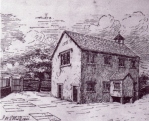 |
Some of the original members of the Bast House congregation left to found Dundee Chapel, Holcombe; however, Richard Kay the younger, Samuel Wareing, Robert Wareing and Richard Hampson decided to build a new chapel in the centre of Bury, and, on 10th December, 1719, this first chapel opened in Silver Street. |
This first chapel was often termed the "little yellow chapel", because the inside walls were colour - washed in buff or light yellow. One of the founders, Samuel Wareing, died in 1742 and willed a small estate of land for the upkeep of the Ministry. This was to play a significant part in the future of the church.
Towards Unitarianism - the First Dissenting Sunday School
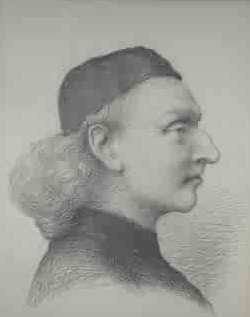 |
The transition from the Trinitarianism of Henry Pendlebury (in whose memory a brass tablet, somewhat ironically, is to be seen on the floor of Bury Parish Church) to the Unitarianism of today began even in the time of the original chapel's first Minister, the Rev. Thomas Braddock (illustrated here). The chapel, however, was not known as Unitarian: its certificate of registration, in 1719, refers to a "congregation of Protestant Dissenters". Towards the end of the second Ministry - that of the Rev. John Hughes - comes the first reference to the "Presbyterian Chapel". The Reverend William Allard, appointed in 1803, was the first true Unitarian Minister. He conducted a vigorous Unitarian propaganda campaign in the district and invited the celebrated Unitarian activist, Richard Wright, to help him. In order to teach children, Allard obtained the use of a warehouse off Silver Street, and, in 1805, the first dissenting Sunday School in Bury opened. |
The Second Chapel, 1837
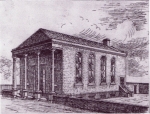 |
Allard died in 1831, and the Rev. Franklin Howarth succeeded him. By now, the congregation was flourishing so greatly that a larger building became necessary. This second chapel, built on the site of the present offices (The Exchange), at a cost of £4,000 (over £300,000 today!), was opened in 1837. It was classical in design, with a portico of four large pillars, and could seat 800 people, though, according to the records, it was barely large enough for the people then attending. It had not been built for long however when, either because of foundation problems caused by the excavations for the East Lancashire Railway, or because of faulty construction, it became unsafe as a building and had to be demolished. Click here to view a map of Bury in 1845 The site of the Unitarian Chapel can be seen prior to the construction of the railway cutting which was to follow the line of "Manchester Street". |
The Third Building - 1852
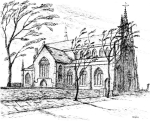 |
The third Bank Street Chapel was opened on Friday, 22nd October, 1852. The collection on the two opening days realised £626 10s (about £54,000 today!), this was sufficient to clear the congregation's debt! The only complaint seems to have concerned the smallness of the pulpit. The larger ministers had difficulty in entering, and even more in leaving! It was replaced by a larger stone pulpit in 1878. |
The
Chancel Window
|
|
The
chancel window in the 3rd church was 11 feet 8 inches in width, and about 29
feet in height, It dates from the building of the Chapel in 1852 The larger part
is divided into ten sections by four mullions and a transom
Above there as a very elaborate tracery forming 23 sections.
There are, in all, 12 figures in the window.
In the apex is a coloured cross,
beneath which are six figures of angels playing the double flute, bag pipes,
cymbals, horn and two are playing the harp Right
and left of these are four angels bearing scrolls, which are inscribed with the
words "Glory to God in the highest, on earth peace, goodwill to men! Below
are four adoring angels and the emblems of the four evangelists, the Angel,
Lion, Bull and Eagle. |
Ten large figures occupy the greater
part of the window below the tracery, Christ holding in his hand the Orb of
Sovereignty is in the centre, In his right are St Matthew and St Mark, on his
left St Luke and St John, Below Are five martyrs, John the Baptist being in the
centre holding a lamb, thus symbolising John I 29 "Behold the lamb of God,
which taketh away the sins of the world” On his right is
At the
feet of these ten figures are
scenes from the life of Jesus vis, Jesus in the Manger, Jesus among the
doctors, The Baptism of Jesus, Jesus blessing the children, Jesus at
Unitarian Teaching Controversy
Growing disagreement between Mr. Howarth and his congregation led to his resignation in 1853. Everyone held him in high regard for his saintly character and the depth of his devotion, but many of his congregation, particularly the younger element, felt that devotion needed to be stiffened with doctrine, and that the chapel was losing its distinctive characteristics of free and fearless thought and enquiry. In other words, more Unitarian teaching was required, and Mr. Howarth was not prepared to supply it. Mr. Howarth left to establish the Christian Church "in bondage to no denomination". The Rochdale Road Church is currently used as an Asian mini-market.
The Rev. John Wright - Active Unitarian
The congregation showed its true colours by appointing the Rev. John Wright, a very active Unitarian, to succeed Mr. Howarth. He had already given evidence at Macclesfield of his energy and organising zeal for the Unitarian cause. He continued to show these same qualities at Bank Street for the next twenty years; services of worship were also started at Heywood, and this led to the formation of a congregation there in 1856. Later, a church was built in Brittain Hill.
1866 & 1868 - Bank Street School building and Day School opened
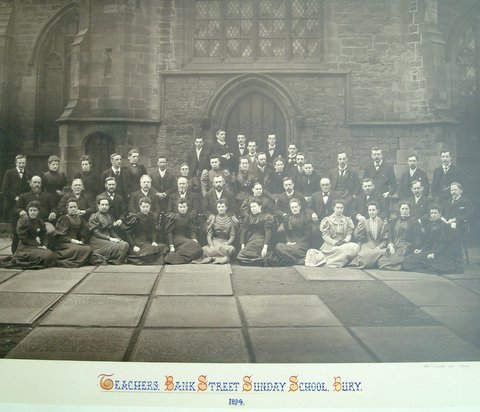 |
A day school was founded in 1868 and continued to function until 1909. The Bank Street School building had been erected two years previously, in 1866, and, in 1885, a new lecture-hall and the caretaker's house were added. About this time, the Sunday School at Bank Street listed approximately 500 names on its register. In 1894 there were 47 teachers alone! |
Chesham Church
 |
The building that was to become Chesham Church actually started life as a bowls club! It was during the ministry of the Rev. Douglas Walmsley (1873-1893) that the church was actually founded. On the day of its inauguration - Sunday, October 29th - a party of Bank Street members, led by the minister, Mr. Walmsley, walked from their church to the present building at Chesham for a service of worship, at which the congregation was so large that the younger children had to be sent home because of shortage of room. The Sunday School opened the following week, with fifty-nine scholars, a number which, by the end of the year, had almost doubled. |
By 1885, Chesham was sufficiently well-established to appoint its own resident minister, and, in October, the Rev. Henry Wheaton took office. Progress continued, and the building of yet another chapel was discussed. Alderman John Duckworth, the first Mayor of Bury, was the owner of the school-property, and he was so interested that he offered to build a chapel and hand it over, with the school, if the congregation could raise an endowment of £1,000. It was a formidable challenge, but, though this was eagerly pursued, the congregation lost much of its initial impetus following Mr. Wheaton's resignation. His successor, the Rev. Alfred Lancaster, attempted to revive the endowment fund, but Mr. Duckworth's death, in 1887, ended his efforts, and the plan for a chapel-building had to be abandoned.
For the most part, Bank Street and Chesham worked well together, and, when the Rev. Alfred Lancaster ceased to be Minister of Chesham, in June, 1889, Bank Street gave much practical assistance. Finance was a serious problem for Chesham, but the congregation was determined to carry on, even without a resident minister. Evening services were suspended, but a morning service for scholars was continued by an earnest band of workers.
By 1896, the congregation had re-started evening services. For ten months, these were held regularly, with the help of neighbouring Ministers and lay-preachers, and, though services were suspended for a few months during the summer of 1897, a successful Harvest Festival Service gave sufficient encouragement for them to be continued. A resident Minister was again appointed: James Mason Bass, and he was inducted in June, 1898. By the end of the following year, the financial position had been strengthened, to the extent that the congregation was now able to purchase the school-building, and, during the sixteen years of Mr. Bass' ministry, continued to maintain a steady existence.
World Wars
At the onset of the 20th Century, institutional life in the churches was firmly-established. In addition to the usual Sunday services and the Sunday School, there was a large number of flourishing social groups; Sunday School picnics, Whit Walks, New Year's Eve parties and Bonfires were also held.
The two wars, of necessity, curtailed such activities. During the Second World War, Bank Street School premises were largely taken over by the A.T.S., and the evening service was changed to an afternoon one. The unlit streets also affected attendance at meetings, but organisations managed to continue in existence throughout the period, and, in sorrow and in sympathy, members drew closer together. In a crowded Bank Street Church, whose minister was the Rev. J. W. Maw, a Thanksgiving Service was held on Wednesday, 9th May, 1945, to commemorate the official end of the war in Europe; after this, the pre-war pattern slowly returned.
Chesham Minstrels 1947/48
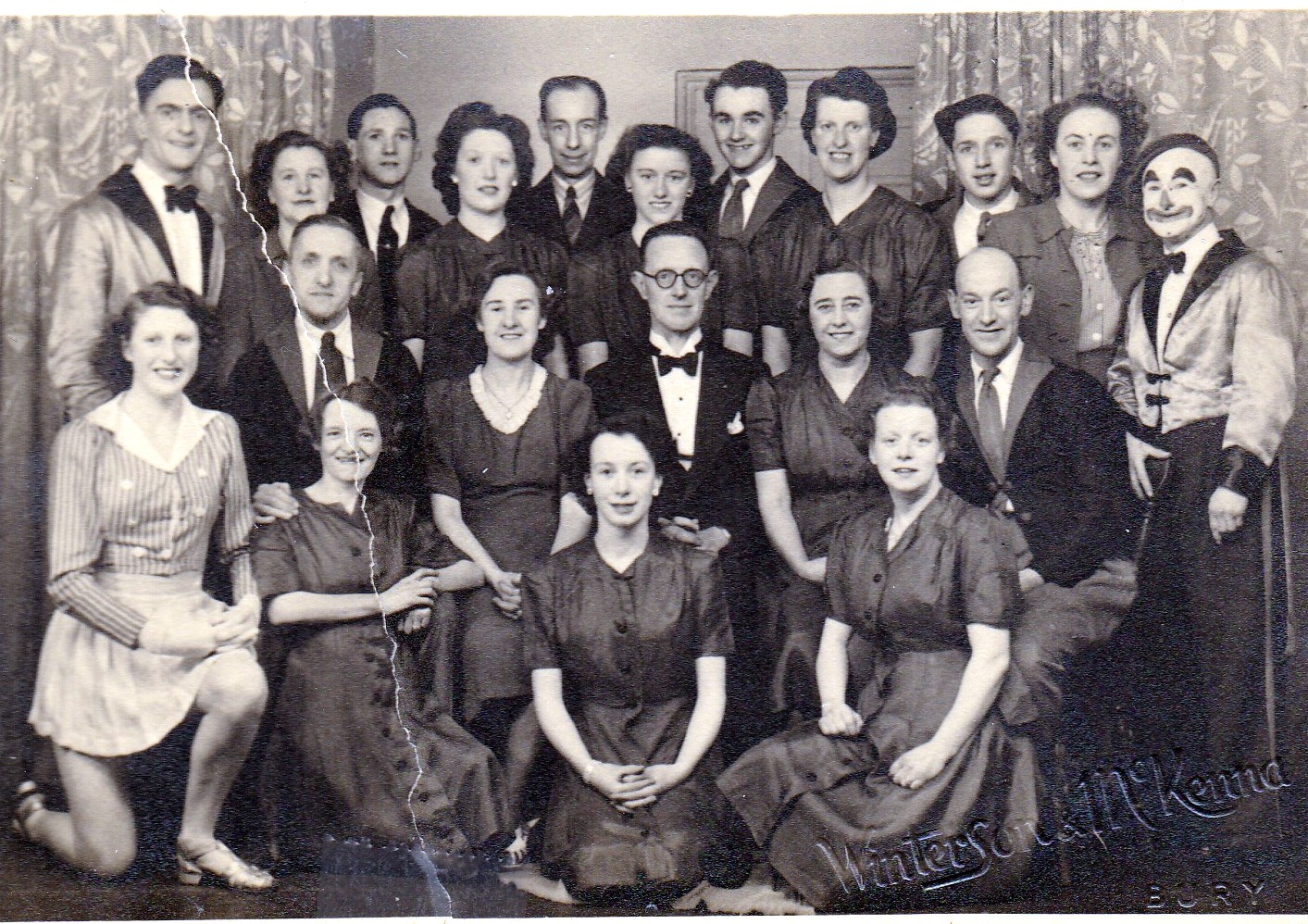
|
Left to Right: Back Row: Norman Whitaker, Nellie Edwards, Eddie Roberts, Fred Spencer, Hilda Barlow, Stanley Bolton, Dorothy Birch (Pianist), Sidney Collins, ? Mitchinson, Johnny Smith. Middle Row: ? Davenport (Drummer), Vi Mitchinson, Harry Wilde, Emily Hargeaves, Albert Smith. Front Row: Pat Lupino Thonpson, ? Bolton, Barbara Smith, Elsie Wilde. Read a report from a newspaper in 1954 about this group |
Financial problems again
In spite of frequent large Bazaars, Sales of Work and other money-raising activities, the two wars left both churches with financial problems. The high costs of heating, lighting and repairs became a drain on the resources of the Bank Street congregation, whilst Chesham, with its lack of endowment funds, was glad of the additional income from the letting of its school-premises to the local authority for educational purposes.
Centenary at Bank Street
Denominational Interests
During the ministry of the Rev. F. M. Ryde (1951-65), an increasing interest was shown by Bank Street in denominational affairs. The church played a leading role in the activities of the Bury Group of Churches and the Bury and District Unitarian Sunday School Union, and the congregation produced a President for the National Unitarian Sunday School Association; two National Presidents for the Unitarian Young People's League; and various officers for the Northern Sunday School Federation; Mr. Ryde, personally, held office in the North & East Lancashire Unitarian Mission, the N.S.S.F. and the Council of the National Unitarian Assembly.
Sunday School becomes Junior Church
Early in the ministry of the Rev. James McClelland, the Sunday School at Bank Street merged entirely with the church's junior section; it met on Sunday mornings and comprised a creche, primary and junior groups and a teenage discussion-group. Coffee was served afterwards, in a lounge successfully converted from the former Men's Clubroom. At Chesham, too, under the joint ministry of the Revs. Donald Mills of Ainsworth and James McClelland of Bank Street, the Sunday School concentrated on Sunday mornings, with Brownies and Cub Scouts holding a parade service on one Sunday each month.
North - East Lancashire Group Ministry
Under the guidance of the N.E. Lancs. Unitarian Mission, three churches at Ainsworth, Bank Street and Chesham were linked together under the ministries of the Revs. Donald Mills and James McClelland; they were further linked in a group-ministry with Accrington, Colne, Newchurch, Padiham, Rawtenstall and Todmorden. The grouping-arrangement brought the constituent congregations into closer fellowship with one another, and greater concern was shown by all for the welfare of the sister churches.
In 1982, the Group-Ministry was reduced because of the closure of the Colne and Accrington Churches. Todmorden was then linked with Rochdale and Oldham. Bury maintained strong links with Ainsworth.
In 2005 the church at Newchurch closed.
Amalgamation of the Three Bury Churches
Chesham was having difficulty with the heating of its premises and had lost income from the day-school, which had moved to a brand new building. In 1969, extensive areas of wet and dry rot were discovered in both the Church and Sunday School buildings at Bank Street. Agreement was reached with the Local Authority for the redevelopment of the Church Graveyard as an open garden for public use, maintained by the Local Authority on lease from the Church.
A decision was taken to sell the Chesham Church, and the Bank Street Church and its Sunday School, for development and to construct a new church on the area previously used as Bank Street's car-park.
Britain Hill Church - Heywood
 |
Unitarianism first started in Heywood in the year 1856. There was probably only one family of Unitarians resident in the town, that being the Nuttall family of Broadfield Farm. They had a fairly large family and used to go regularly to the Unitarian Church at Bury, taking their meals with them. The Nuttalls were instrumental in bringing missionaries into the town. The late William Wild was interested and used to travel to Bury to attend the Unitarian Church. Britain Hill church was first established by the efforts of Rev J Wright of Bank Street Presbyterian Church in Bury and Rev B Glover a lay preacher from Bury and the Mission Committee. A Sunday school met from 1857, initially at Oak Street, and was replaced by the new church in 1860 with a fine Burne-Jones window (pictured left). The first minister, John Fox, was appointed in 1864. A fire in 1968 and other difficulties led to the congregation deciding to amalgamate with the Bank Street and Chesham congregations To read a more detailed account of the first 100 years of Unitarianism in Heywood Click here. |
George Street Ragged School
 |
In the period between the demolition of the old
church and the completion of the new one, temporary accommodation was generously
provided by George Street Ragged School. Now demolished and its site
redeveloped), for which the trustees and congregation of Bury Unitarian Church
were grateful. When the new church was opened, the Ragged School had to close,
but a small number of its members joined the new church. To read a more about the Ragged School Click here. |
Bury Unitarian Church
This fourth Church was to be called "Bury Unitarian Church" The new title, was engraved on the existing war memorial. This had previously been within the Bank Street church-graveyard area and bore the names of Bank Street church-members who had lost their lives in the wars of 1914/18 and 1939/45. It would subsequently form the centrepiece of the new public garden. Two side-panels were added to the memorial, and these bore the names of those members of the Chesham and Britain Hill congregations who had fallen in the two World Wars.
Holebottom
One of the founders of the first chapel in Bury was Samuel Wareing. He was also to be one of our most generous benefactors but he very nearly failed in his wishes to endow the church.
In 1742, Samuel Wareing willed a small estate of land of approximately 5½ acres, by the name of Hagg, or Holebottom, to the then Presbyterian Church. The income from this estate was to be used for the maintenance of the minister, or teachers, of a Presbyterian congregation which assembled in or near Bury. Unfortunately, his will was declared invalid, and the estate passed jointly to Samuel's heirs - four daughters and one son-in-law. The heirs generously decided to honour their father's wishes and agreed to sell the estate to the then church-trustees for a nominal sum. Again, fate intervened; before the transaction was complete, two of the four daughters died (fortunately, for us, "intestate, unmarried and without issue"). The remaining owners of the estate agreed to sell the land as before; a new agreement was drawn up and, this time, executed, without further problem.
In the early days, the estate was a source of many problems. The church found itself at the centre of more than one dispute between tenant-farmers about access-rights.
In 1852, the graveyard in front of the third church at Bank Street became full, and a new burial-ground was established on land owned by the church which was part of the Holebottom Estate.
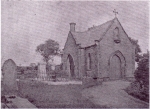 |
A Cemetery Chapel, of Cumberland walling, was built on the site. It was formally opened at a dedication service on Whit Sunday, May 31st,1857. Burials continued there until 1972; the Cemetery finally closed on January 1st,1979. 1975, the Cemetery Chapel, severely damaged by vandals, was demolished, in the interests of safety. In 1979, once the Cemetery itself had been closed, extensive safety and remedial measures were taken |
The area continued to give cause for concern, until, by 2000, it had again fallen into a derelict and dangerous state; it was cleared, landscaped and maintained as a local amenity, with clear grassy areas, improved boundary-walls and access-provision. The war-graves were retained, and a commemorative plaque installed. Recently a large number of bulbs and some additional trees have been planted with assistance from Bury Groundwork Trust.
In 1997, the remaining land at Holebottom which was owned by the church was sold for development. The proceeds from this, restricted by the terms of Samuel Wareing's will, nevertheless ensure the financial stability of the Unitarian Ministry in Bury for many years to come.
The Fourth Building - Bury Unitarian Church
In 1972, ill-health caused the resignation of the Rev. J. McClelland, and, in 1973, the Rev. John Allerton was appointed to the joint ministry of the Ainsworth and Bury Churches.
 |
The new Bury Unitarian Church was designed and constructed by local architects James T Ratcliffe. An interesting artice was published at the time in "Sacred Suburbs Portfolio" in which the church design was described as "a well detailed, functional, yet flexible building". Click here to read the full article. The church was opened in 1974, with a service of dedication on Saturday, 9 March. The total cost, including furnishings, was £85,000. (It is now valued at about £1.5 million) The Churchwarden and Chairman of Trustees, at that time, was Bernard Haughton, who had succeeded Alex Rogers; he was to serve the Church in those capacities for the next 25 years. He was succeeded by Barbara Ashworth, our immediate past Warden. During this time, notwithstanding persistent problems with water leakage through its flat roof, the church continued to thrive and develop. |
Enhancements have been made to improve the comfort and amenities of the building throughout the period with, for example, the installation of an improved heating - system, a sound - enhancement system in the church, and disabled access facilities including a lift to the upper floor. Through the efforts of Barbara Ashworth (past Church Warden), the proliferation of bequests, legacies and trusts which were complicating and restricting church-finances has been rationalised and the financial structure streamlined. Part of the land at Holebottom has been sold for development, and part has been upgraded as a public amenity – see above section.
John Allerton, the first minister of the fourth church retired at the end of February 2007 after serving for 34 years. He was succeeded in March 2007 by the Rev. Jeffrey Lane Gould who unexpectedly resigned from his post in October 2010 to be followed by a series of visiting preachers before Rev. Beryl Allerton (wife of John, our first minister at this church) initially took up a post of Interim Minister. Beryl remained as our permanent minister for 5 years until her retirement from the ministry in 2016. She was succeeded by Rev. Kate McKenna who is our current minister.
The current congregation is still one of the best supported Unitarian Churches in the country and remains enthusiastic and committed to the Unitarian faith. There are many social groups including The Women's League, The Men's Fellowship, The Luncheon Club the Book Club and most recently, our Camera Club; coffee is served every Saturday morning – a session which welcomes members of the public to the church, some of whom have subsequently become church-members. Frequent social activities are organised by The Efforts Committee and are well-supported by the congregation and their friends and raise money in support of the activities of the church snd local charities.
The Church Bell
|
|
Our bell is now situated at the front of the worship area of the present church which is the fourth on this site. It was previously hung in all of the previous churches and was originally cast in 1777 for the 1st chapel which was built in 1719. It is inscribed "Come away make no delay" and carries the date 1777 with the initials ‘T֠ R’, either side of a bell, indicating it was cast by Thomas Rudhall of |
The Future

|
We acknowledge with pride our debt to the past: to those who fought for our freedom in worship; to those who have carried their faith out into the town, as public servants; to those who, in their private lives, have been an inspiration to their contemporaries. We look forward in faith; the future will depend, as did the past, on the commitment of each worshipper. Ours is a living tradition - long may it continue and prosper The "People Praising", pictured left, is a 12 foot high original sculpture at the front or our church which represents the family of the church. It has been created by Elizabeth Mulchinock. |
List of past Ministers from the Bank Street, Chesham, Heywood and Bury Churches
INTRODUCTORY BOOKLET:
A
FAITH WORTH THINKING ABOUT

click here for a free download
Bury Unitarian Church
1 Bank Street
Bury
Lancashire
BL9 0DN
0161 761 3785
Charity Registration No. 1078570
© Bury Unitarian Church 2017
